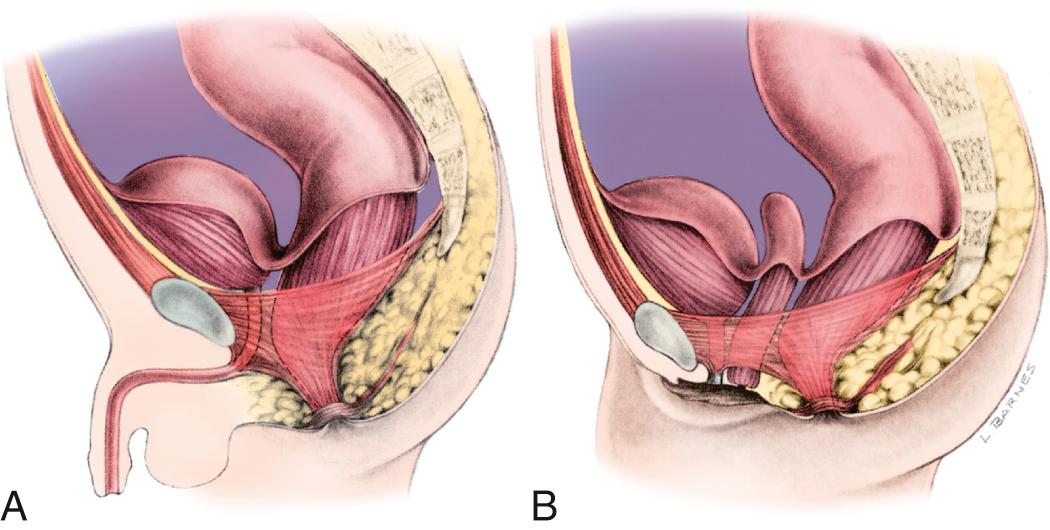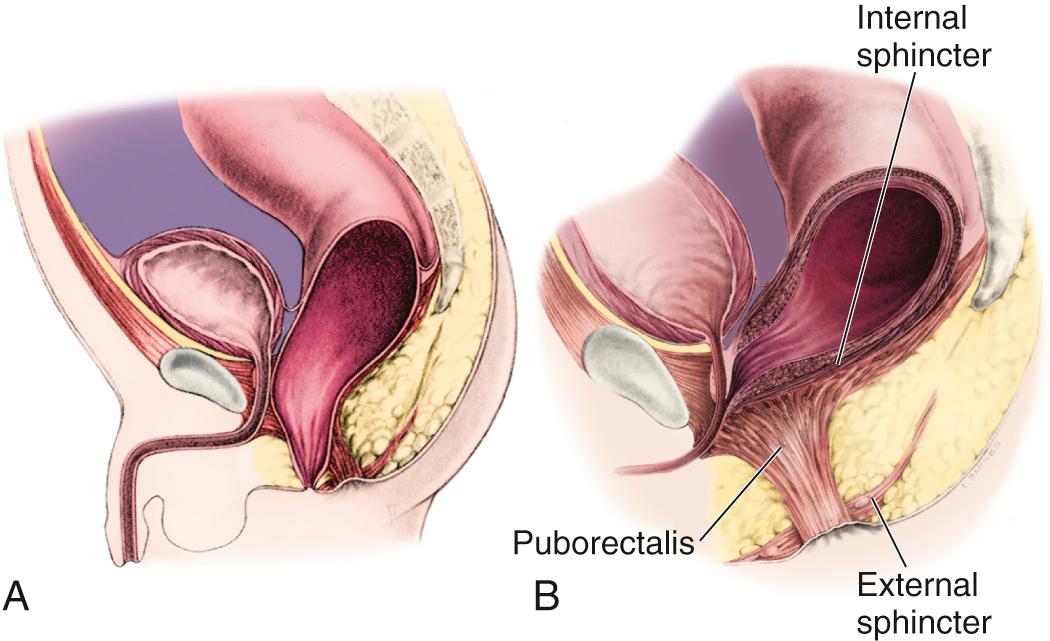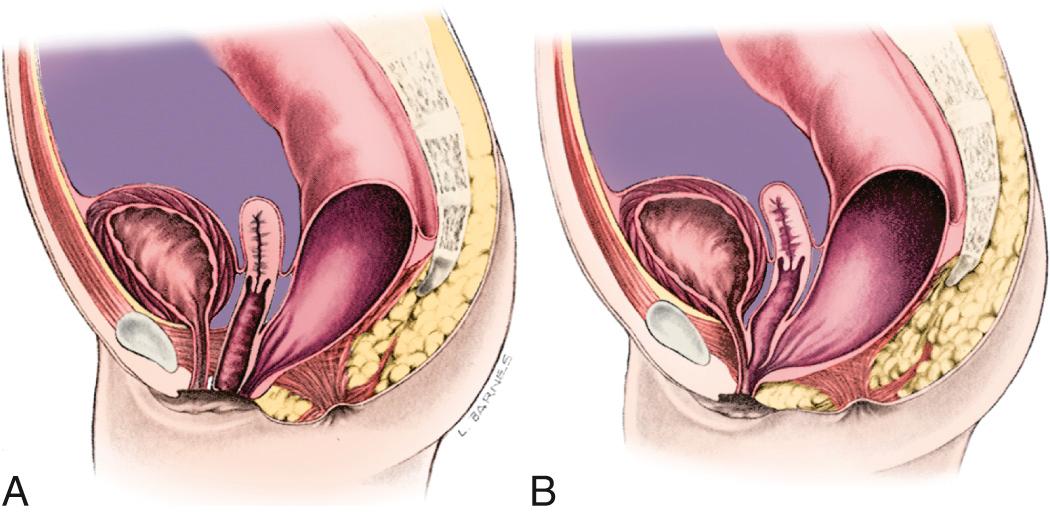Physical Address
304 North Cardinal St.
Dorchester Center, MA 02124
Imperforate anus
Perineal fistula
Fourchette fistula
Rectovaginal fistula
Cloaca
Rectourethral fistula
Caudal regression
Anal stenosis
Anterior ectopic anus
Rectal atresia
Currarino triad
Tethered Cord
PSARP: Posterior sagittal anorectoplasty
Fecal continence
ACE Antegrade continence enema
MACE Malone antegrade continence enema
To fully understand the spectrum of anorectal anomalies, it is necessary to consider the importance of the sphincter complex, a mass of muscle fibers surrounding the anorectum ( Fig. 371.1 ). This complex is the combination of the puborectalis, levator ani, external and internal sphincters, and the superficial external sphincter muscles, all meeting at the rectum. Anorectal malformations are defined by the relationship of the rectum to this complex and include varying degrees of stenosis to complete atresia. The incidence is 1/3,000 live births. Significant long-term concerns focus on bowel control and urinary and sexual functions.

The hindgut forms early as the part of the primitive gut tube that extends into the tail fold in the 2nd wk of gestation. At about day 13, it develops a ventral diverticulum, the allantois, or primitive bladder. The junction of allantois and hindgut becomes the cloaca, into which the genital, urinary, and intestinal tubes empty. This is covered by a cloacal membrane. The urorectal septum descends to divide this common channel by forming lateral ridges, which grow in and fuse by the middle of the 7th wk. Opening of the posterior portion of the membrane (the anal membrane) occurs in the 8th wk. Failures in any part of these processes can lead to the clinical spectrum of anogenital anomalies.
Imperforate anus can be divided into low lesions, where the rectum has descended through the sphincter complex, and high lesions, where it has not. Most patients with imperforate anus have a fistula. There is a spectrum of malformation in males and females. In males, low lesions usually manifest with meconium staining somewhere on the perineum along the median raphe ( Fig. 371.2 A ). Low lesions in females also manifest as a spectrum from an anus that is only slightly anterior on the perineal body to a fourchette fistula that opens on the moist mucosa of the introitus distal to the hymen ( Fig. 371.3 A ). A high imperforate anus in a male has no apparent cutaneous opening or fistula, but it usually has a fistula to the urinary tract, either the urethra or the bladder (see Fig. 371.2 B ). Although there is occasionally a rectovaginal fistula, in females, high lesions are usually cloacal anomalies in which the rectum, vagina, and urethra all empty into a common channel or cloacal stem of varying length (see Fig. 371.3 B ). The interesting category of males with imperforate anus and no fistula occurs mainly in children with trisomy 21. The most common lesions are the rectourethral bulbar fistula in males and the rectovestibular fistula in females; the 2nd most common lesion in both sexes is the perianal fistula ( Fig. 371.4 ).



There are many anomalies associated with anorectal malformations ( Table 371.1 ). The most common are anomalies of the kidneys and urinary tract in conjunction with abnormalities of the sacrum. This complex is often referred to as caudal regression syndrome . Males with a rectovesical fistula and patients with a persistent cloaca have a 90% risk of urologic defects. Other common associated anomalies are cardiac anomalies and esophageal atresia with or without tracheoesophageal fistula. These can cluster in any combination in a patient. When combined, they are often accompanied by abnormalities of the radial aspect of the upper extremity and are termed the VACTERL ( v ertebral, a nal, c ardiac, t racheal, e sophageal, r enal, l imb) anomalad.
| GENITOURINARY |
|
| VERTEBRAL |
|
| CARDIOVASCULAR |
|
| GASTROINTESTINAL |
|
| CENTRAL NERVOUS SYSTEM |
|
Anorectal malformations, particularly anal stenosis and rectal atresia, can also present as Currarino triad, which includes sacral agenesis, presacral mass, and anorectal stenosis. These patients present with a funnel appearing anus, have sacral bony defects on plain x-ray, and have a presacral mass (teratoma, meningocele, dermoid cyst, enteric cyst) on exam or imaging. It is an autosomal dominant disorder due in most patients to a mutation in the MNX1 gene.
A good correlation exists between the degree of sacral development and future function. Patients with an absent sacrum usually have permanent fecal and urinary incontinence. Spinal abnormalities and different degrees of dysraphism are often associated with these defects. Tethered cord occurs in approximately 25% of patients with anorectal malformations. Untethering of the cord can lead to improved urinary and rectal continence in some patients, although it seldom reverses established neurologic defects. The diagnosis of spinal defects can be screened for in the first 3 mo of life by spinal ultrasound, although MRI is the imaging method of choice if a lesion is suspected. In older patients, MRI is needed.
Examination of a newborn includes the inspection of the perineum. The absence of an anal orifice in the correct position leads to further evaluation. Mild forms of imperforate anus are often called anal stenosis or anterior ectopic anus . These are typically cases of an imperforate anus with a perineal fistula. The normal position of the anus on the perineum is approximately halfway (0.5 ratio) between the coccyx and the scrotum or introitus. Although symptoms, primarily constipation, have been attributed to anterior ectopic anus (ratio: <0.34 in females, <0.46 in males), many patients have no symptoms.
If no anus or fistula is visible, there may be a low lesion or covered anus . In these cases, there are well-formed buttocks and often a thickened raphe or bucket handle . After 24 hr, meconium bulging may be seen, creating a blue or black appearance. In these cases, an immediate perineal procedure can often be performed, followed by a dilation program.
In a male, the perineal (cutaneous) fistula can track anteriorly along the median raphe across the scrotum and even down the penile shaft. This is usually a thin track, with a normal rectum often just a few millimeters from the skin. Extraintestinal anomalies are seen in <10% of these patients.
In a female, a low lesion enters the vestibule or fourchette (the moist mucosa outside the hymen but within the introitus). In this case, the rectum has descended through the sphincter complex. Children with a low lesion can usually be treated initially with perineal manipulation and dilation. Visualizing these low fistulas is so important in the evaluation and treatment that one should avoid passing a nasogastric tube for the first 24 hr to allow the abdomen and bowel to distend, pushing meconium down into the distal rectum.
In a male with a high imperforate anus, the perineum appears flat. There may be air or meconium passed via the urethra when the fistula is high, entering the bulbar or prostatic urethra, or even the bladder. In rectobulbar urethral fistulas (the most common in males), the sphincter mechanism is satisfactory, the sacrum may be underdeveloped, and an anal dimple is present. In rectoprostatic urethral fistulas , the sacrum is poorly developed, the scrotum may be bifid, and the anal dimple is near the scrotum. In rectovesicular fistulas , the sphincter mechanism is poorly developed, and the sacrum is hypoplastic or absent. In males with trisomy 21, all the features of a high lesion may be present, but there is no fistula, the sacrum and sphincter mechanisms are usually well developed, and the prognosis is good.
In females with high imperforate anus, there may be the appearance of a rectovaginal fistula. A true rectovaginal fistula is rare. Most are either the fourchette fistulas described earlier or are forms of a cloacal anomaly.
In persistent cloaca, the embryologic stage persists in which the rectum, urethra, and vagina communicate in a common orifice, the cloaca. It is important to realize this, because the repair often requires repositioning the urethra and vagina as well as the rectum. Children of both sexes with a high lesion require a colostomy before repair.
Rectal atresia is a rare defect occurring in only 1% of anorectal anomalies. It has the same characteristics in both sexes. The unique feature of this defect is that affected patients have a normal anal canal and a normal anus. The defect is often discovered while rectal temperature is being taken. An obstruction is present approximately 2 cm above the skin level. These patients need a protective colostomy. The functional prognosis is excellent because they have a normal sphincteric mechanism (and normal sensation), which resides in the anal canal.
Evaluation includes identifying associated anomalies (see Table 371.1 ). Careful inspection of the perineum is important to determine the presence or absence of a fistula. If the fistula can be seen there, it is a low lesion. The invertogram or upside-down x-ray is of little value, but a prone crosstable lateral plain x-ray at 24 hr of life (to allow time for bowel distention from swallowed air) with a radiopaque marker on the perineum can demonstrate a low lesion by showing the rectal gas bubble <1 cm from the perineal skin (see Fig. 371.4 ). A plain x-ray of the entire sacrum, including both iliac wings, is important to identify sacral anomalies and the adequacy of the sacrum. An abdominal-pelvic ultrasound and voiding cystourethrogram must be performed. The clinician should also pass a nasogastric tube to identify esophageal atresia and should obtain an echocardiogram. In males with a high lesion, the voiding cystourethrogram often identifies the rectourinary fistula. In females with a high lesion, more invasive evaluation, including vaginogram and endoscopy, is often necessary for careful detailing of the cloacal anomaly.
Good clinical evaluation and a urinalysis provide enough data in 80–90% of male patients to determine the need for a colostomy. Voluntary sphincteric muscles surround the most distal part of the bowel in cases of perineal and rectourethral fistulas, and the intraluminal bowel pressure must be sufficiently high to overcome the tone of those muscles before meconium can be seen in the urine or on the perineum. The presence of meconium in the urine and a flat bottom are considered indications for the creation of a colostomy. Clinical findings consistent with the diagnosis of a perineal fistula represent an indication for an anoplasty without a protective colostomy. Ultrasound is valuable not only for the evaluation of the urinary tract, but it can also be used to investigate spinal anomalies in the newborn and to determine how close to the perineum the rectum has descended.
More than 90% of the time, the diagnosis in females can be established on perineal inspection. The presence of a single perineal orifice is a cloaca. A palpable pelvic mass (hydrocolpos) reinforces this diagnosis. A vestibular fistula is diagnosed by careful separation of the labia, exposing the vestibule. The rectal orifice is located immediately in front of the hymen within the female genitalia and in the vestibule. A perineal fistula is easy to diagnose. The rectal orifice is located somewhere between the female genitalia and the center of the sphincter and is surrounded by skin. Less than 10% of these patients fail to pass meconium through the genitalia or perineum after 24 hr of observation. Those patients can require a prone crosstable lateral film.
Sometimes a perineal fistula, if it opens in good position, can be treated by simple dilation. Hegar dilators are employed, starting with a No. 5 or 6 and letting the baby go home when the mother can use a No. 8. Twice-daily dilatations are done at home, increasing the size every few weeks until a No. 14 is achieved. By 1 yr of age, the stool is usually well formed and further dilation is not necessary. By the time No. 14 is reached, the examiner can usually insert a little finger. If the anal ring is soft and pliable, dilation can be reduced in frequency or discontinued.
Occasionally, there is no visible fistula, but the rectum can be seen to be filled with meconium bulging on the perineum, or a covered anus is otherwise suspected. If confirmed by plain x-ray or ultrasound of the perineum that the rectum is <1 cm from the skin, the clinician can do a minor perineal procedure to perforate the skin and then proceed with dilation or do a simple perineal anoplasty.
When the fistula orifice is very close to the introitus or scrotum, it is often appropriate to move it back surgically. This also requires postoperative dilation to prevent stricture formation. This procedure can be done any time from the newborn period to 1 yr. It is preferable to wait until dilatations have been done for several weeks and the child is bigger. The anorectum is a little easier to dissect at this time. The posterior sagittal approach of Peña is used, making an incision around the fistula and then in the midline to the site of the posterior wall of the new location. The dissection is continued in the midline, using a muscle stimulator to be sure there is adequate muscle on both sides. The fistula must be dissected cephalad for several centimeters to allow posterior positioning without tension. If appropriate, some of the distal fistula is resected before the anastomosis to the perineal skin.
In children with a high lesion, a double-barrel colostomy is performed. This effectively separates the fecal stream from the urinary tract. It also allows the performance of an augmented pressure colostogram before repair to identify the exact position of the distal rectum and the fistula. The definitive repair or posterior sagittal anorectoplasty (PSARP) is performed at about 1 yr of age. A midline incision is made, often splitting the coccyx and even the sacrum. Using a muscle stimulator, the surgeon stays strictly in the midline and divides the sphincter complex and identifies the rectum. The rectum is then opened in the midline and the fistula is identified from within the rectum. This allows a division of the fistula without injury to the urinary tract. The rectum is then dissected proximally until enough length is gained to suture it to an appropriate perineal position. The muscles of the sphincter complex are then sutured around (and especially behind) the rectum.
Other operative approaches (such as an anterior approach) are used, but the most popular procedure is by laparoscopy. This operation allows division of the fistula under direct visualization and identification of the sphincter complex by transillumination of perineum. Other imaging techniques in the management of anorectal malformations include 3D endorectal ultrasound, intraoperative MRI, and colonoscopy-assisted PSARPs, which may help perform a technically better operation. None of these other procedures or innovations has demonstrated improved outcomes.
A similar procedure can be done for female high anomalies with variations to deal with separating the vagina and rectum from within the cloacal stem. When the stem is longer than 3 cm, this is an especially difficult and complex procedure.
Usually the colostomy can be closed 6 wk or more after the PSARP. Two weeks after any anal procedure, twice-daily dilatations are performed by the family. By doing frequent dilatations, each one is not so painful and there is less tissue trauma, inflammation, and scarring.
Become a Clinical Tree membership for Full access and enjoy Unlimited articles
If you are a member. Log in here